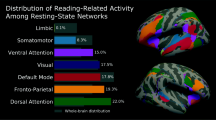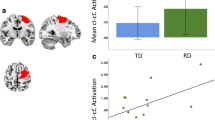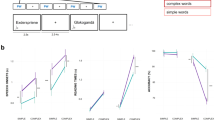Abstract
The Reading Acceleration Program is a computerized program that improves reading and the activation of the error-detection mechanism in individuals with reading difficulty (RD) and typical readers (TRs). The current study aims to find the neural correlates for this effect in English-speaking 8–12-year-old children with RD and TRs using a functional connectivity analysis. Functional magnetic resonance imaging data were collected during a lexical decision task before and after 4 weeks of training with the program, together with reading and executive functions measures. Results indicated improvement in reading, visual attention, and speed of processing in children with RD. Following training, greater functional connectivity was observed between the left fusiform gyrus and the right anterior cingulate cortex in children with RD and between the left fusiform gyrus and the left anterior cingulate cortex in TRs. The change in functional connectivity after training was correlated with increased behavioral scores for word reading and visual attention in both groups. The results support previous findings of improved monitoring and mental lexicon after training with the Reading Acceleration Program in children with RD and TRs. The differences in laterality of the anterior cingulate cortex in children with RD and the presumable role of the cingulo-opercular control network in language processing are discussed.




Similar content being viewed by others
References
Altemeier, L. E., Abbott, R. D., & Berninger, V. W. (2008). Executive functions for reading and writing in typical literacy development and dyslexia. Journal of Clinical and Experimental Neuropsychology, 30, 588–606. doi:10.1080/13803390701562818.
Andersen, A. (2002). Assessment and development of executive function (EF) during childhood. Child Neuropsychology: A Journal on Normal and Abnormal Development in Childhood and Adolescence, 8, 71–82. doi:10.1076/chin.8.2.71.8724.
Anwander, A., Tittgemeyer, M., von Cramon, D. Y., Friederici, A. D., & Knosche, T. R. (2007). Connectivity-based parcellation of Broca’s area. Cerebral Cortex, 17, 816–825.
Baddeley, A. (1986). Modularity, mass-action and memory. Quarterly Journal of Experimental Psychology. A, Human Experimental Psychology, 38, 527–533. doi:10.1080/146407486 08401613.
Baria, A. T., Baliki, M. N., Parrish, T., & Apkarian, A. V. (2011). Anatomical and functional assemblies of brain BOLD oscillations. Journal of Neuroscience, 31, 7910–7919. doi:10.1523/JNEUROSCI. 1296-11.2011.
Benjamin, C. F. A., & Gaab, N. (2012). What’s the Story? The Tale of Reading Fluency Told at Speed. Organization of Human Brain Mapping (HBM). 33, 2572–2585.
Botvinick, M., Nystrom, L. E., Fissell, K., Carter, C. S., & Cohen, J. D. (1999). Conflict monitoring versus selection-for-action in anterior cingulate cortex. Nature, 402, 179–181.
Bremner, J. D., Vythilingam, M., Vermetten, E., Vaccarino, E., & Charney, D. S. (2004). Deficits in hippocampal and anterior cingulate functioning during verbal declarative memory encoding in midlife major depression. The American Journal of Psychiatry, 161, 637–664.
Breznitz, Z. (1987). Increasing first graders’ reading accuracy and comprehension by accelerating their reading rate. Journal of Educational Psychology, 79, 236–242.
Breznitz, Z. (1992). Verbal indicators of depression. Journal of General Psychology, 119, 351–363.
Breznitz, Z. (1997a). Enhancing the reading of dyslexic children by reading acceleration and auditory masking. Journal of Educational Psychology, 89, 103–113.
Breznitz, Z. (1997b). Effects of accelerated reading rate on memory for text among dyslexic readers. Journal of Educational Psychology, 89, 289–297.
Breznitz, Z. (2006). Fluency in reading: synchronization of processes. Mahwah, NJ: Erlbaum.
Breznitz, Z., & Berman, L. (2003). The underlying factors of word reading rate. Educational Psychology Review, 15, 247–265.
Breznitz, Z., & Leikin, M. (2000). Effects of accelerated reading rate on processing words’ syntactic functions by normal and dyslexic readers: event related potentials evidence. Journal of Genetic Psychology, 162, 276–296.
Breznitz, Z., & Misra, M. (2003). Speed of processing of the visual–orthographic and auditory– phonological systems in adult dyslexics: the contribution of ‘‘asynchrony” to word recognition deficits. Brain Lang, 85, 486–502.
Breznitz, Z., & Bloch, B. (2008). The Reading Acceleration Program (RAP). University of Haifa, Israel: The Edmond J. Safra Brain Research Center for the Study of Learning Disabilities. http://carmel3.haifa.ac.il/index.php/2014-06-09-08-40-46/education-humanities1/54-readingacceleration-program-rap.
Breznitz, Z., & Share, D. L. (1992). The effect of accelerated reading rate on memory for text. Journal of Educational Psychology, 84, 193–200.
Breznitz, Z., Shaul, S., Horowitz-Kraus, T., Sela, I., Nevat, M., & Karni, A. (2013). Enhanced reading by training with imposed time-constraint in typical and dyslexic adults. Nature Communications, 4, 1486. doi:10.1038/ncomms2488.
Brosnan, M., Demetre, J., Hamill, S., Robson, K., Shepherd, H., & Cody, G. (2002). Executive functioning in adults and children with developmental dyslexia. Neuropsychologia, 40, 2144–2155. doi:10.1016/S0028-3932(02)00046-5.
Brown, L., Sherbenou, R., & Johnsen, S. (1997). Test of nonverbal intelligence (3rd ed.). Austin, TX: Pro-Ed.
Byars, A. W., Holland, S. K., Strawsburg, R. H., Bommer, W., Dunn, R. S., Schmithorst, V. J., et al. (2002). Practical aspects of conducting large-scale functional magnetic resonance imaging studies in children. Journal of Child Neurology, 17, 8858–8890.
Carter, C. S., Braver, T. S., Barch, D. M., Botvinick, M. M., Noll, D., & Cohen, J. D. (1998). Anterior cingulate cortex, error detection, and the online monitoring of performance. Science, 280, 747–749.
Conners, C. K. (1989). Conners rating scales’ manual. North Towonada NY: Multihealth System.
Crespo-Facorro, B., Kim, J., Andreasen, N. C., O’Leary, D. S., Wiser, A. K., Bailey, J. M., et al. (1999). Human frontal cortex: an MRI-based parcellation method. NeuroImage, 10, 500–519.
De Jong, P. F. (1998). Working memory deficits of reading disabled children. Journal of Experimental Child Psychology, 70, 75–96.
Dellis, D. C., Kaplan, E., & Kramer, J. H. (2001). Delis-Kaplan executive function system. San Antonio, TX: Psychological Corporation.
Dosenbach, N. U. F., Fair, D. A., Cohen, A. L., Schlaggar, B. L., & Peterson, S. E. (2008). A dual-networks architecture of top-down control. Trends in Cognitive Sciences, 12, 99–105.
Eden, G. F., Jones, K. M., Cappell, K., Gareau, L., Wood, F. B., Zeffiro, T. A., et al. (2004). Neural changes following clinical study remediation in adult developmental dyslexia. Neuron, 44, 411–422.
Facoetti, A., Paganoni, P., Turatto, M., Marzola, V., & Mascetti, G. G. (2000). Visual-spatial attention in developmental dyslexia. Cortex, 36, 109–123.
Falkenstein, M., Hohnsbein, J., Hoormann, J., & Blanke, L. (1991). Effects of crossmodal divided attention on late ERP components. II. Error processing in choice reaction tasks. Electroencephalography and Clinical Neurophysiology, 78(6), 447–455. doi:10.1016/0013-4694(91)90062–9.
Fletcher, J. (2009). Dyslexia: the evolution of a scientific concept. Journal of the International Neuropsychological Society, 15, 501–508.
Garavan, H., Ross, T. J., & Stein, E. A. (1999). Right hemispheric dominance of inhibitory control: an event-related functional MRI study. Proceedings of the National Academy of Sciences of the United States of America, 96, 8301–8306.
Gooch, D., Snowling, M., & Hulme, C. (2011). Time perception, phonological skills and executive function in children with dyslexia and/or ADHD symptoms. Journal of Child Psychology and Psychiatry, 52, 195–203. doi:10.1111/j.1469- 7610.2010.02312.
Helland, T., & Asbjornsen, A. (2000). Executive functions in dyslexia. Child Neuropsychology, 6, 37–48. doi:10.1076/0929-7049(200003)6:1;1-B;FT037.
Hirshorn, E. A., & Thompson-Schill, S. L. (2006). Role of the left inferior frontal gyrus in covert word retrieval: neural correlates of switching during verbal fluency. Neuropsychologia, 44, 2547–2557.
Horowitz-Kraus, T., & Breznitz, Z. (2010). Less is more: the ability of the error-detection system to change after training among dyslexics. Barcelona, Spain: Organization of Human Brain Mapping (HBM).
Horowitz-Kraus, T. (2012). Pinpointing the deficit in executive functions in teenage dyslexic readers: an ERP study using the Wisconsin Card Sorting Test. Journal of Learning Disabilities, 47, 208–223.
Horowitz-Kraus, T., Vannest, J. J., Kadis, D., Cicchino, N., Wang, Y. Y., & Holland, S. K. (2015). Reading acceleration training changes brain circuitry in children with reading difficulties. Brain and Behavior, 4(6), 886–902.
Horowitz-Kraus, T., & Breznitz, Z. (2013). Can reading rate acceleration training improve executive functions in adolescents with reading difficulties and in typical readers. Brain Research, 1544, 1–14.
Horowitz-Kraus, T., Cicchino, N., Amiel, M., Holland, S. K., & Breznitz, Z. (2014). Reading improvement in English and Hebrew-speaking children with reading difficulties after reading acceleration training. Annals of Dyslexia. doi:10.1007/s11881-014-0093-4.
Horowitz-Kraus, T., Vannest, J. J., Cicchino, N., Kay, B., Wang, Y., Breznitz, Z., et al. (2013). Can we train the dyslexic’s brain to read like a typical readers? An fMRI study. Seattle, USA: Organization of Human Brain Mapping (OHBM).
Houde, O., Rossi, S., Lubin, A., & Joliot, M. (2010). Mapping numerical processing, reading, and executive functions in the developing brain: an fMRI meta-analysis of 52 studies including 842 children. Developmental Science, 13, 876–885.
Hye Youn Park, H. Y., Hwang, J. Y., Jung, W. H., Shin, N. Y., Shim, G., Jang, J. H., et al. (2013). Altered asymmetry of the anterior cingulate cortex in subjects at genetic high risk for psychosis. Schizophrenia Research, 150, 512–518.
Korinth, S. P., Dimigen, O., Sommer, W., & Breznitz, Z. (2009). Eye movements altered through training: Effects of the reading acceleration program. Poster presented at the Edmond J. Safra Inaugural Conference, Haifa, Israel.
Langer, N., Benjamin, C., Minas, J., & Gaab, N. (2013). The Neural Correlates of Reading Fluency Deficits in Children, Cereb. Cortex. doi:10.1093/cercor/bht33
Levy, B. J., & Anderson, M. C. (2002). Inhibitory processes and the control of memory retrieval. Trends in Cognitive Sciences, 6, 299–305.
Luria, A. R. (1973). The working brain. New York, NY: Basic.
Lutcke, H., & Frahm, J. (2008). Lateralized anterior cingulate function during error processing and conflict monitoring as revealed by high-resolution fMRI. Cerebral Cortex, 18, 508–515. doi:10.1093/cercor/bhm090.
Manly, T., Robertson, I. H., Anderson, V., & Nimmo-Smith, I. (1999). TEA-Ch: the test of everyday attention for children manual. Bury St. Edmunds, UK: Thames Valley Test Company.
Masur, D., Shinar, S., Cnaan, A., Clark, P., Wang, J., Weiss, E. F., et al. (2013). Pretreatment cognitive deficits and treatment effects on attention in childhood absence epilepsy. Neurology, 81, 1572–1580.
Menghini, D., Finzi, A., Benassic, M., Bolzanic, R., Facoettid, A., Giovagnolic, S., et al. (2010). Different underlying neurocognitive deficits in developmental dyslexia: a comparative study. Neuropsychologia, 48, 863–872. doi:10.1016/j.neuropsychologia.2009.11.003.
Neta, M., Schlaggar, B. L., & Peterson, S. E. (2014). Separable responses to error, ambiguity, and reaction time in cingulo-opercular task control regions. NeuroImage, 99, 59–68.
Niedo, J., Lee, Y., Breznitz, B., & Berninger, V. (2013). Response to silent reading rate training at transition to silent reading for fourth graders with silent reading rate disabilities. Learning Disability Quarterly. doi:10.1177/0731948713507263.
Reiter, A., Tucha, O., & Lange, K. W. (2004). Executive functions in children with dyslexia. Dyslexia, 11, 116–131. doi:10.1002/dys.28.
Ridderinkhof, K. R., Ullsperger, M., Crone, E. A., & Nieuwenhuis, S. (2004). The role of the medial frontal cortex in cognitive control. Science, 306, 443–447.
Ridderinkhof, K. R., van den Wildenberg, W. P. M., Segalowitz, S. J., & Carter, C. S. (2004). Neurocognitive mechanisms of cognitive control: the role of prefrontal cortex in action selection, response inhibition, performance monitoring, and reward based learning. Brain and Cognition, 56, 129–140.
Shaywitz, S. E., & Shaywitz, B. A. (2008). Paying attention to reading: the neurobiology of reading and dyslexia. Development and Psychopathology, 20, 1329–1349.
Shaywitz, S. E., Shaywitz, B. A., Fulbright, R. K., Skudlarski, P., Mencl, W. E., Constable, R. T., et al. (2003). Neural systems for compensation and persistence: Young adult outcome of childhood reading disability. Biological Psychiatry, 54, 25–33.
Snellings, P., van der Leij, A., de Jong, P. F., & Block, H. (2009). Enhancing reading fluency and comprehension of children with learning disabilities in an orthographically transparent language. Journal of Learning Disabilities, 42, 1–15.
Sowell, E. R., Thompson, P. M., Holmes, C. J., Jernigan, T. L., & Toga, A. W. (1999). In vivo evidence for post-adolescent brain maturation in frontal and striatal regions. Nature Neuroscience, 2, 859–861. doi:10.1038/13154.
Stephan, K. E., Marshall, J. C., Friston, K. J., Rowe, J. B., Ritzl, A., Zilles, K., et al. (2003). Lateralized cognitive processes and lateralized task control in the human brain. Science, 301, 384–386.
Taylor, S. F., Martis, B., Fitzgerald, K. D., Welsh, R. C., Abelson, J. L., Liberzon, I., et al. (2006). Medial frontal cortex activity and loss-related responses to errors. Journal of Neuroscience, 26, 4063–4070.
Tiffin-Richards, M. C., Hasselhorn, M., Woerner, W., Rothenberger, A., & Banaschewski, T. (2008). Executive functions in children with chronic tic disorders with/without ADHD: new insights. Journal of Neural Transmission, 115, 227–234. doi:10.1007/s00702-007-0816-3.
Torgesen, J. K., Wagner, R. K., & Rashotte, C. A. (1999). Test of word-reading efficiency (TOWRE). Austin, TX: Pro-Ed.
Ullsperger, M., & von Cramon, D. Y. (2004). Neuroimaging of performance monitoring: error detection and beyond. Cortex, 40, 593–604.
van der Mark, S., Klaver, P., Bucher, K., Maurer, U., Schulz, E., Brem, S., et al. (2011). The left occipitotemporal system in reading: disruption of focal fMRI connectivity to left inferior frontal and inferior parietal language areas in children with dyslexia. NeuroImage, 54, 2426–2436.
van der Sluis, S., de Jong, P. F., & van der Leij, A. (2004a). Inhibition and shifting in children with learning deficits in arithmetic and reading. Journal of Experimental Child Psychology, 87, 239–266. doi:10.1016/j.jecp.2003.12.002.
van der Sluis, S., de Jong, P. F., & van der Leij, A. (2004b). Executive functioning in children, and its relations with reasoning, reading and arithmetic. Intelligence, 35, 427–449.
Vigneau, M., Beaucousin, V., Herve, P. Y., Duffau, H., Crivello, F., Houde, O., et al. (2006). Meta-analyzing left hemisphere language areas: phonology, semantics, and sentence processing. NeuroImage, 30, 1414–1432.
Vogel, A. C., Petersen, S. E., & Schlaggar, B. L. (2014). The VWFA: it’s not just for words anymore. Frontiers in Human Neuroscience, 8, 1–10.
Wagner, R. K., Torgesen, J. K., & Rashotte, C. A. (1999). Comprehensive test of phonological processing (CTOPP). Austin, TX: Pro-Ed.
Wechsler, D. (1999). Wechsler Intelligence Scale for Children—Third Edition (WAIS-III). New York: Psychological Corporation.
Whitfield-Gabrieli, S., & Nieto-Castanon, A. (2012). Conn: a functional connectivity toolbox for correlated and anticorrelated brain networks. Brain Connectivity, 2, 125–141. doi:10.1089/brain.2012.0073.
Wiederholt, J. L., & Bryant, B. R. (1992). Gray oral reading test (3rd ed.). Austin, TX: Pro-Ed.
Woodcock, R. W., & Johnson, M. B. (1989). Woodcock-Johnson Psycho-Educational Battery—Revised (WJ-R). Allen, TX: Developmental Learning Materials.
Yeung, N., Cohen, J. D., Botvinick, M. M. (2004). The neural basis of error detection: conflict
Yücel, M., Stuart, G. W., Maruff, P., Velakoulis, D., Crowe, S. F., Savage, G., et al. (2001). Hemispheric and gender-related differences in the gross morphology of the anterior cingulate/paracingulate cortex in normal volunteers: an MRI morphometric study. Cerebral Cortex, 11, 17–25. doi:10.1093/cercor/11.1.17.
Ziegler, J. C., & Goswami, U. (2005). Reading acquisition, developmental dyslexia, and skilled reading across languages: a psycholinguistic grain size theory. Psychological Bulletin, 131, 3–29.
Acknowledgments
The study was supported by the University of Cincinnati Grant and the Fulbright Foundation. The Reading Acceleration Program was developed by Prof. Zvia Breznitz and was provided by the Edmond J. Safra Brain Research Center for the Study of Learning Disabilities, University of Haifa, Israel. The authors thank J. Denise Wetzel, CCHMC Medical Writer, for editing the manuscript.
Author information
Authors and Affiliations
Corresponding author
Rights and permissions
About this article
Cite this article
Horowitz-Kraus, T., Holland, S.K. Greater functional connectivity between reading and error-detection regions following training with the reading acceleration program in children with reading difficulties. Ann. of Dyslexia 65, 1–23 (2015). https://doi.org/10.1007/s11881-015-0096-9
Received:
Accepted:
Published:
Issue Date:
DOI: https://doi.org/10.1007/s11881-015-0096-9




